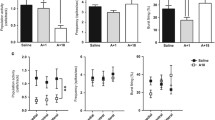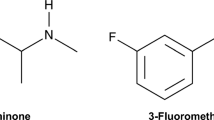Summary
Locomotor stimulation induced in mice by morphine and amphetamine was antagonized by pretreatment withγ-butyrolactone (GBL) and aminooxyacetic acid (AOAA) at doses which had little effect on saline treated animals. The effects of morphine and AOAA on the turnover of brain catecholamines (CA) were determined by measuring both the accumulation of dopa after inhibition of central aromatic L-amino acid decarboxylase and by measuring the depletion of noradrenaline (NA) after inhibition of tyrosine hydroxylase byα-methyltyrosine (α-MT). Morphine and AOAA were found to have opposite effects on CA turnover,i.e. morphine caused an increase and AOAA, a decrease. AOAA also antagonized the morphine-induced increase in CA turnover. These data might suggest that the well documented ability of GABAergic drugs to inhibit the firing of DA-containing neurons may be of importance in explaining the present findings. However, the locomotor stimulation induced by the directly-acting CA agonists, apomorphine and clonidine after pretreatment with reserpine andα-MT was also inhibited by the GABAergic drugs. It is therefore concluded that the suppressant effects of the GABAergic agents on hypermotility are not solely mediated by their effects on presynaptic CA mechanisms, but also by a postsynaptic inhibition at some point beyond the CA neurons.
Similar content being viewed by others
References
Andén, N.-E.: Inhibition of the turnover of the brain dopamine after treatment with the gammaaminobutyrate: 2-oxyglutarate transaminase inhibitor aminooxyacetic acid. Naunyn-Schmiedeberg's Arch. Pharmacol.283, 419–424 (1974).
Andén, N.-E., Stock, G.: Inhibitory effect of gammahydroxybutyric acid and gammaaminobutyric acid on the dopamine cells in the substantia nigra. Naunyn-Schmiedeberg's Arch. Pharmacol.279, 89–92 (1973).
Andén, N.-E., Wachtel, H.: Biochemical effects of baclofen (β-parachlorophenyl-GABA) on the dopamine and noradrenaline in the rat brain. Acta pharmacol. et toxicol.40, 310–320 (1977).
Atack, C., Lindqvist, M.: Conjoint native and orthophthaldialdehydecondensate assays for the fluorimetric determination of 5-hydroxyindoles in brain. Naunyn-Schmiedeberg's Arch. Pharmacol.279, 267–284 (1973).
Atack, C., Magnusson, T.: Individual elution of noradrenaline (together with adrenaline), dopamine, 5-hydroxytryptamine and histamine from a single, strong cation exchange column, by means of mineral acid organic solvent mixtures. J. Pharm. Pharmacol.22, 625–627 (1970).
Bartholini, G., Stadler, H.: Cholinergic and GABAergic influence on the dopamine release in extrapyramidal centers. In: Chemical Tools in Catecholamine Research, Vol. II (Almgren, O., Carlsson, A., Engel, J., eds.), pp. 235–241. Amsterdam: North-Holland. 1975.
Bédard, P., Carlsson, A., Lindqvist, M.: Effect of a transverse cerebral hemisection on 5-hydroxytryptamine metabolism in the rat brain. Naunyn-Schmiedeberg's Arch. Pharmacol.272, 1–15 (1972).
Bertler, Å., Carlsson, A., Rosengren, E.: A method for the fluorimetric determination of adrenaline and noradrenaline in tissues. Acta physiol. scand.44, 273–292 (1958).
Carlsson, A.: Dopaminergic autoreceptors. In: Chemical Tools in Catecholamine Research, Vol. II (Almgren, O., Carlsson, A., Engel. J., eds.), pp. 219–225. Amsterdam: North-Holland Publ. Co. 1975.
Carlsson, A., Biswas, B.: Effect of GABA, administered intracerebroventricularly or intraperitoneally, on brain monoamines and on locomotor activity. Paper presented at the International Symposium on “Interactions among putative neurotransmitters in the brain”, Milan, Italy, October 26–28, 1976.
Carlsson, A., Davis, J. N., Kehr, W., Lindqvist, M., Atack, C. V.: Simultaneous measurement of tyrosine and tryptophan hydroxylase activities in brainin vivo using an inhibitor of the aromatic amino acid decarboxylase. Naunyn-Schmiedeberg's Arch. Pharmacol.275, 153–168 (1972).
Clouet, D. H.: Possible roles of catecholamines in the action of narcotic drugs. In: Catecholamines and Behavior, Vol. 2 (Friedhoff, A. J., ed.), pp. 167–196. New York: Plenum. 1976.
Cools, A. R., Janssen, H. J.:γ-Aminobutyric acid: the essential mediator of behaviour triggered by neostriatally applied apomorphine and haloperidol. J. Pharm. Pharmacol.28, 70–74 (1976).
Costa, E., Garattini, S., eds.: International Symposium on Amphetamines and Related Compounds. New York: Raven Press. 1970.
Cott, J. M., Carlsson, A., Engel, J., Lindqvist, M.: Suppression of ethanol-induced locomotor stimulation by GABA-like drugs. Naunyn-Schmiedeberg's Arch. Pharmacol.295, 203–209 (1976).
Cott, J., Engel, J.: Antagonism of the analeptic activity of thyrotropinreleasing hormone (TRH) by agents which enhance GABA transmission. Psychopharmacology. In press (1976).
Dray, A., Straughan, D. W.: Synaptic mechanisms in the substantia nigra. J. Pharm. Pharmacol.28, 400–405 (1976).
Engel, J., Carlsson, A.: Catecholamines and behavior. In: Current Developments in Psychopharmacology (Valzelli, L., Essman, W. B., eds.), Vol. 4, pp. 2–32. New York: Spectrum Pub. Inc. 1976.
Fahn, S.: Regional distribution studies of GABA and other putative neurotransmitters and their enzymes. In: GABA in Nervous System Function (Roberts, E., Chase, T. N., Tower, D. B., eds.), pp. 169–186. New York: Raven Press. 1976.
Fuxe, K., Hökfelt, T., Ljungdahl, Å., Agnati, L., Johansson, O., Perez de la Mora, M.: Evidence for an inhibitory gabergic control of the mesolimbic dopamine neurons: possibility of improving treatment of schizophrenia by combined treatment with neuroleptics and gabergic drugs. Medical Biology53, 177–183 (1975).
Green, A. R., Tordoff, A. F. C., Bloomfield, M. R.: Elevation of brain GABA concentrations with amino-oxyacetic acid: effect on the hyperactivity syndrome produced by increased 5-hydroxytryptamine synthesis in rats. J. Neural Transmission39, 103–112 (1976).
Hornykiewicz, O., Lloyd, K. G., Davidson, L.: The GABA system, function of the basal ganglia, and Parkinson's disease. In: GABA in Nervous System Function (Roberts, E., Chase, T. N., Tower, O. B., eds.), pp. 479 to 485. New York: Raven Press. 1976.
Iversen, L. L., Schon, F. E.: The use of autoradiographic techniques for the identification and mapping of transmitter specific neurones in CNS. In: New Concepts in Neurotransmitter Regulation (Mandel, A., ed.), pp. 153–193. New York: Plenum Press. 1973.
Kääriäinen, L: Effects of aminooxyacetic acid and baclofen on the catalepsy and the increase of mesolimbic and striatal dopamine turnover induced by haloperidol in rats. Acta pharmacol. et toxicol.39, 393–400 (1976).
Kehr, W., Carlsson, A., Lindqvist, M.: A method for the determination of 3, 4-dihydroxyphenylalanine (DOPA) in brain. Naunyn-Schmiedeberg's Arch. Pharmacol.274, 273–280 (1972).
Kuschinsky, K.: Actions of narcotics on brain dopamine metabolism and their relevance for “psychomotor” effects. Arzneim.-Forsch. (Drug Res.)26, 563–567 (1976).
McGeer, P. L., Fibiger, H. C., Maler, L., Hattori, T., McGeer, E. G.: Evidence for descending pallido-nigral GABA-containing neurons. In: Advances in Neurology, Vol. 5 (McDowell, F., Barbeau, A., eds.), pp. 153–160. New York: Raven Press. 1974.
Melberg, P.-E., Ahlenius, S., Engel, J., Lundborg, P.: Ontogenic development of locomotor activity and rate of tyrosine hydroxylation. Psychopharmacology49, 119–123 (1976).
Peričić, D., Walters, J. R.: Dopamine in substantia nigra and cortex afterγ-butyrolactone treatment. J. Pharm. Pharmacol.28, 527–530 (1976).
Pycock, C., Horton, R.: Evidence for an accumbens-pallidal pathway in the rat and its possible gabaminergic control. Brain Res.110, 629–634 (1976 a).
Pycock, C., Horton, R.: Possible GABA-mediated control of dopamine-dependent behavioural effects from the nucleus accumbens of the rat. Psychopharmacology49, 173–178 (1976 b).
Roberts, E.: A model of the vertebrate nervous system based largely on disinhibition: a key role of the GABA system. In: Neurohumoral Coding of Brain Function (Myers, R. D., ed.), pp. 419–449, New York: Plenum Press. 1974.
Roth, R. H., Suhr, Y.: Mechanism of theγ-hydroxybutyrate-induced increase in brain dopamine and its relationship to “sleep”. Biochem. Pharmac.19, 3001–3012 (1970).
Roth, R. H., Walters, J. R., Agbajanian, G. K.: Effect of impulse flow on the release and synthesis of dopamine in the rat striatum. In: Frontiers of Catecholamine Research (Usdin, E., Snyder, S., eds.), pp. 567–574. New York: Pergamon. 1973.
Roth, R. H., Walters, J. R., Morgenroth, V. H., III: Effects of alterations in impulse flow on transmitter metabolism in central dopaminergic neurons. In: Neuropsychopharmacology of Monoamines and Their Regulatory Enzymes (Usdin, E., ed.), pp. 369–384. New York: Raven Press. 1974.
Stock, G., Magnusson, T., Andén, N.-E.: Increase in brain dopamine after axotomy or treatment with gammahydroxybutyric acid due to elimination of the nerve impulse flow. Naunyn-Schmiedeberg's Arch. Pharmacol.275, 347–361 (1973).
Waalkes, T. P., Udenfriend, S.: A fluorometric method for the estimation of tyrosine in plasma and tissues. J. Lab. clin. Med.50, 733–736 (1957).
Wachtel, H., Andén, N.-E.: Motor activity following injections of GABA and GABA-like drugs into the nucleus accumbens. (In manuscript.)
Wallach, D. P.: Studies on the GABA pathway. 1. The inhibition ofγ-aminobutyric acid-α-ketogluturic acid transaminase in vitro and in vivo by U-7524 (aminooxyacetic acid). Biochem. Pharmac.5, 323–331 (1961).
Author information
Authors and Affiliations
Rights and permissions
About this article
Cite this article
Cott, J., Engel, J. Suppression by GABAergic drugs of the locomotor stimulation induced by morphine, amphetamine, and apomorphine: Evidence for both pre- and post-synaptic inhibition of catecholamine systems. J. Neural Transmission 40, 253–268 (1977). https://doi.org/10.1007/BF01257019
Received:
Issue Date:
DOI: https://doi.org/10.1007/BF01257019




